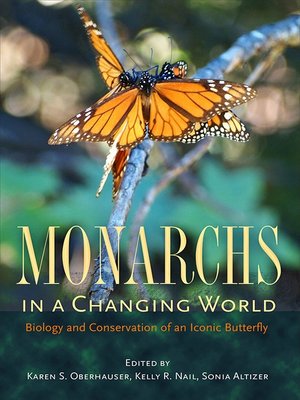Monarchs in a Changing World
ebook ∣ Biology and Conservation of an Iconic Butterfly
By Karen S. Oberhauser

Sign up to save your library
With an OverDrive account, you can save your favorite libraries for at-a-glance information about availability. Find out more about OverDrive accounts.
Find this title in Libby, the library reading app by OverDrive.



Search for a digital library with this title
Title found at these libraries:
| Loading... |
Monarch butterflies are among the most popular insect species in the world and are an icon for conservation groups and environmental education programs. Monarch caterpillars and adults are easily recognizable as welcome visitors to gardens in North America and beyond, and their spectacular migration in eastern North America (from breeding locations in Canada and the United States to overwintering sites in Mexico) has captured the imagination of the public.
Monarch migration, behavior, and chemical ecology have been studied for decades. Yet many aspects of monarch biology have come to light in only the past few years. These aspects include questions regarding large-scale trends in monarch population sizes, monarch interactions with pathogens and insect predators, and monarch molecular genetics and large-scale evolution. A growing number of current research findings build on the observations of citizen scientists, who monitor monarch migration, reproduction, survival, and disease. Monarchs face new threats from humans as they navigate a changing landscape marked by deforestation, pesticides, genetically modified crops, and a changing climate, all of which place the future of monarchs and their amazing migration in peril.
To meet the demand for a timely synthesis of monarch biology, conservation and outreach, Monarchs in a Changing World summarizes recent developments in scientific research, highlights challenges and responses to threats to monarch conservation, and showcases the many ways that monarchs are used in citizen science programs, outreach, and education. It examines issues pertaining to the eastern and western North American migratory populations, as well as to monarchs in South America, the Pacific and Caribbean Islands, and Europe. The target audience includes entomologists, population biologists, conservation policymakers, and K–12 teachers.
|Monarch butterflies are among the most popular insect species in the world and are an icon for conservation groups and environmental education programs. Monarch caterpillars and adults are easily recognizable as welcome visitors to gardens in North America and beyond, and their spectacular migration in eastern North America (from breeding locations in Canada and the United States to overwintering sites in Mexico) has captured the imagination of the public.Monarch migration, behavior, and chemical ecology have been studied for decades. Yet many aspects of monarch biology have come to light in only the past few years. These aspects include questions regarding large-scale trends in monarch population sizes, monarch interactions with pathogens and insect predators, and monarch molecular genetics and large-scale evolution. A growing number of current research findings build on the observations of citizen scientists, who monitor monarch migration, reproduction, survival, and disease. Monarchs face new threats from humans as they navigate a changing landscape marked by deforestation, pesticides, genetically modified crops, and a changing climate, all of which place the future of monarchs and their amazing migration in peril. To meet the demand for a timely synthesis of monarch biology, conservation and outreach, Monarchs in a Changing World summarizes recent developments in scientific research, highlights challenges and responses to threats to monarch conservation, and showcases the many ways that monarchs are used in citizen science programs, outreach, and education. It examines issues pertaining to the eastern and western North American migratory populations, as well as to monarchs in South America, the Pacific and Caribbean Islands, and Europe. The target audience includes entomologists,...






